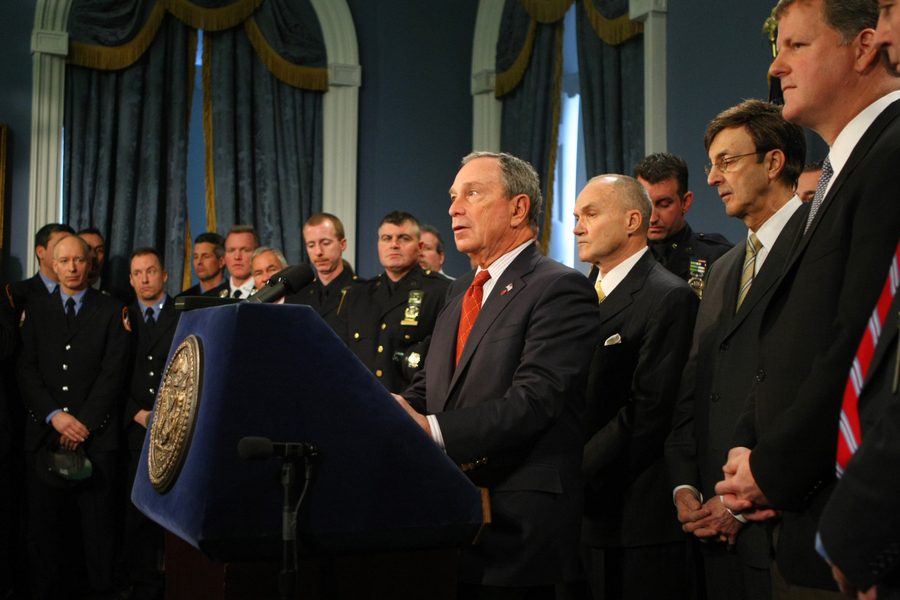Under Bloomberg, the NYPD Massively Expanded Its Racist Gang Database
Stop-and-frisk has received more attention, but Bloomberg’s role in broadening New York’s discriminatory gang database should raise serious concern about what his presidency would look like.
Josmar Trujillo

In the summer of 2013, many activists, like myself, were protesting then-New York Mayor Mike Bloomberg’s stop-and-frisk program, a controversial police tactic that became a centerpiece of his administration. Mayor Bloomberg’s racist policing regime was fueled by both his personal arrogance and the hard-charging style of his police commissioner, Ray Kelly, a former marine. Little did we know, however, that Bloomberg and Kelly were at the time quietly expanding another strategy designed to harass and incarcerate young New Yorkers of color: the NYPD gang database.
A year before, Commissioner Kelly had announced a doubling of the NYPD’s gang unit. Operation Crew Cut, a program where police — in collaboration with prosecutors — surveilled social media and built intelligence on young people they deemed to be gang-involved, was beginning to take shape more publicly. By 2013, Bloomberg’s last year in office, reported stop-and-frisks began to decline while the pivot to tracking and dismantling “crews” was in full swing, even as many anti-violence activists and young men targeted described the tactic as a “virtual stop and frisk.”
Bloomberg had become mayor in 2002, and from 2003 to 2013, the NYPD added over 20,000 people to a secret gang database, according to documents obtained by CUNY Law Professor Babe Howell. The NYPD had operated a gang database with about 5,000 people since at least 2001. And while there may not have been a direct order from Bloomberg to expand the list, all New York City mayors oversee and manage the NYPD, meaning what happens in the department falls at their feet. And under Bloomberg, the police department dramatically expanded the gang database.
More than 99% of those listed during Bloomberg’s administration were non-white. Of those 20,000, 30% were minors when they were added. You could be entered by personnel from the police department, or from intelligence given to the police from the Department of Corrections and even the school safety officers that patrolled NYC public schools.
There was (and remains) no way to find out if you are in the database, let alone challenge your designation as a gang member. The criteria for inclusion, according to Howell’s public-records request, included where you live, who you know, and if you wear certain colors. And, contrary to what one might think of someone who is “gang-involved,” you do not need to be convicted of a crime, according to public records requests and NYPD testimony as recently as 2018.
As Bloomberg and Kelly faced mounting public pressure against stop-and-frisk, as well as their Muslim mapping program, the NYPD was beefing up its Juvenile Justice division, which increasingly monitored social media and lumped youth together as “crews” — informal associations that prosecutors began to charge like organized criminal syndicates.
The NYPD’s turn to a more expanded and sophisticated gang enforcement apparatus during this time conflicted with the fact that alleged gangs account for a tiny fraction of overall crime in the city. And cataloging people in the gang database could result in serious consequences: enhanced bail in court, increased harassment on the street, exclusion from public housing and, most notably, being swept up in so-called “gang takedowns” — militarized police sweeps.
Bloomberg’s police department set the stage for ramped-up gang enforcement, and under Mayor Bill de Blasio (who is currently repudiating Bloomberg’s legacy as a surrogate for presidential candidate Bernie Sanders), the NYPD took full advantage of it. Under de Blasio, the department added over 17,000 people to the database in just a 5-year span, a faster rate than under Bloomberg.
Dubbing the approach “Precision Policing,” de Blasio’s NYPD went on to launch the largest gang takedown in the city’s history just five months into his first term. That 2014 takedown in Harlem netted 103 indictments and raised serious concerns among residents and family members who wanted the city to invest resources into the neighborhood — not gang raids. Less than two years later, de Blasio’s NYPD helped break that record with mass arrests and the indictment of 120 mostly young Black men in a federally-assisted gang takedown in the Bronx.
This “Bronx 120” takedown became the focus of a blistering report by Howell that showed most people arrested weren’t accused of violence and weren’t even deemed gang members by prosecutors. The operation saw Homeland Security armored cars parked in the middle of housing projects and led to dozens being charged under RICO, the federal strategy devised in 1970 to counter the Mafia. One of those arrested, Kraig Lewis, a post-grad student in Connecticut that grew up in the Bronx, became the focus of a documentary, Trouble Finds You, about his journey to federal prison and back after being charged with racketeering.
Gang databases around the country have recently come under increased scrutiny, not unlike stop-and-frisk. In Chicago, local activists have led a campaign to abolish their city’s gang database, and in California, elite police units have been accused of falsifying records to tag people in their database. As such, Bloomberg’s legacy of overseeing a massive expansion of New York City’s gang database must be remembered alongside the injustices of stop-and-frisk.
For those who care about racial and social justice, one has to wonder if Bloomberg will ever be forced to account for how police criminalize communities of color under the banner of fighting gangs. At the controls of the federal government, which under Donald Trump has ramped up gang crackdowns as part of its immigration policy, history tells us that a potential President Bloomberg would bolster an already discriminatory federal gang database system. This prospect presents a dangerous scenario for both Black and immigrant communities.




